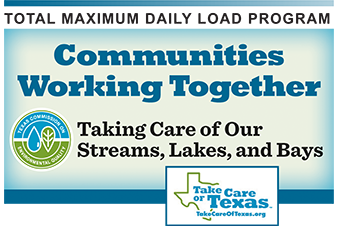Developing TMDL Projects
On this page:
- Overview
- How TMDLs are Counted
- Hydrography Information
- Guidance for Project Leaders
- Federal Regulations and EPA Guidance
- Contact the TMDL Program
Overview
The goal of a Total Maximum Daily Load (TMDL) is to restore the full use of a water body that has limited quality in relation to one or more of its uses. The TMDL defines an environmental target by determining the extent to which a certain pollutant must be reduced in order to attain and maintain the affected use. Based on this environmental target, the state helps stakeholders develop an implementation plan to mitigate sources of pollution within the watershed and restore full use of the water body.
TCEQ and the Texas State Soil and Water Conservation Board (TSSWCB) work closely on the preparation and approval of TMDLs when one or more of the sources of pollution are from agriculture or silviculture. A Memorandum of Agreement between TCEQ and TSSWCB provides the framework for collaboration between the two agencies to develop and implement TMDLs. For additional information or questions about TMDLs managed by TSSWCB, see TSSWCB’s TMDL Program webpage.
For a summary of TCEQ’s approach to defining and managing the quality of surface waters in Texas, see Preserving and Improving Water Quality. Additionally, you can read Texas Surface Water Quality: What Is It, and How Is It Measured? for a brief overview of water quality standards and the criteria by TCEQ evaluates their attainment.
How TMDLs Are Counted
EPA requires one TMDL for each impairment listed in a water body. An impairment is the combination of the use that is affected (such as support of aquatic life) with the pollutant or condition of concern (such as mercury or low dissolved oxygen). For example, if Jones Creek was listed as not meeting the aquatic life use because of low dissolved oxygen concentrations and not meeting the fish consumption use because of mercury in fish tissue, two TMDLs would be required for Jones Creek.
Prior to 2008, the number of impairments was reported by water-quality segment, as required by EPA guidance. During that period, TCEQ used the term “water body” synonymously with “water-quality segment” when reporting how many segments were addressed by TMDLs.
In 2008, EPA began requiring TCEQ to develop and record one impairment (and TMDL) for each assessment unit within a water-quality segment. Consequently, TCEQ reports multiple TMDLs (impairments) where once it would have counted only one. TCEQ continues to report the number of water bodies addressed through TMDLs by water-quality segment.
A water-quality segment is a geographic portion of a river, lake, or bay that has relatively homogeneous chemical, physical, and hydrological characteristics. A segment is assigned a unique number for the purpose of categorization and provides a basic unit for managing water quality. In some cases, a segment may be the same as the entirety of the water body; for example, a small lake may not be divided into multiple numbered segments.
An assessment unit is a further geographic subdivision of a segment. For example, Segment 0200 may have five assessment units.
Projects Develop Multiple TMDLs
To be most efficient with resources of time and money, the TMDL Program may address the same pollutant in multiple water bodies through a single project, or may address multiple similar pollutants (such as three different pesticides) in one segment through a single project. Hence, a single project may produce many TMDLs.
Federal law requires that EPA take formal action to approve or disapprove any TMDLs adopted by the states. So, on any particular date, the number of TMDLs adopted by the Commission may differ from the number approved by EPA.
Hydrography Information
You can review Hydrography Data and Map-Based Viewers for statewide, map-based viewers for surface water information. You will also find links to GIS data for stream segments, Level 4 ecoregions, and other data layers for use in ArcGIS.
Guidance for Project Leaders
A lead organization accepts primary responsibility for guiding a TMDL project. Often, TCEQ is the lead organization. However, TSSWCB, other state agencies, consultants, universities, river authorities, communities, or private consortiums may lead the development of TMDLs. Ultimately, TCEQ is responsible for ensuring that all TMDLs developed for Texas water bodies conform with state and federal law; therefore, TCEQ participates in all TMDL projects, regardless of who leads them.
The June 1999 guidance for the state's TMDL program is no longer applicable to TCEQ's TMDL projects. Guides and procedures provided on this webpage supersede all similar topics addressed in the June 1999 publication. For guidance on topics not addressed on this webpage, please contact the TMDL Program at tmdl@tceq.texas.gov or 512-239-6682.
Collecting Data
Data must be collected and managed under TCEQ guidelines and procedures for collecting quality-assured data. See the Quality Assurance and Monitoring Procedures for Surface Water Quality Monitoring.
Managing Data
Guidance, forms, and contact information for people who monitor and manage surface water quality are provided at Managing Surface Water Quality Data.
Quality Assurance
Quality assurance project plans (QAPPs) or quality assurance plans (QAPs) are required for most TMDL projects. For more information, contact your TCEQ project manager on the TMDL Team.
The Environmental Protection Agency (EPA) provides guidance for quality management on their website. All approved TCEQ QAPPs are consistent with EPA guidance.
See TSSWCB’s Environmental Data Quality Management webpage for their quality assurance documents.
Federal Regulations and EPA Guidance
U.S. EPA administers the federal TMDL program.
Contact the TMDL Program
To contact the TMDL program, email tmdl@tceq.texas.gov or call us at 512-239-6682.



